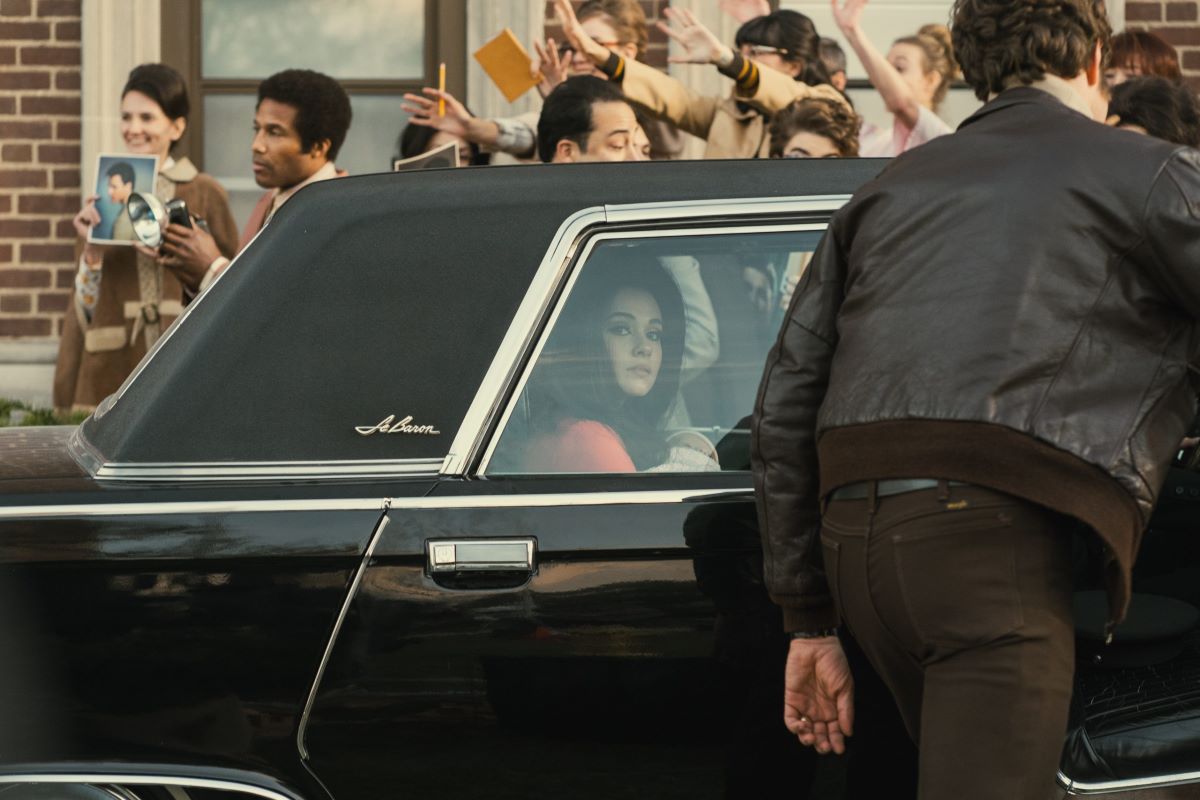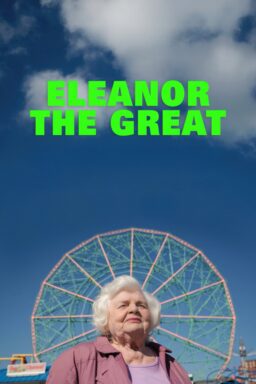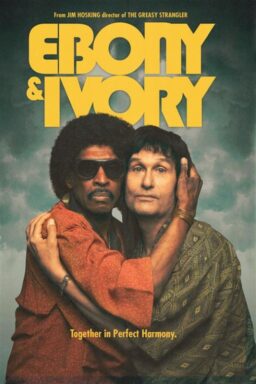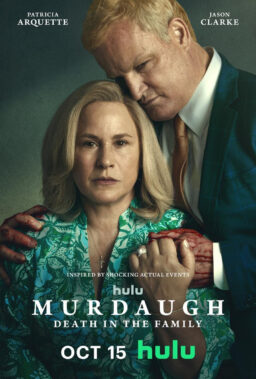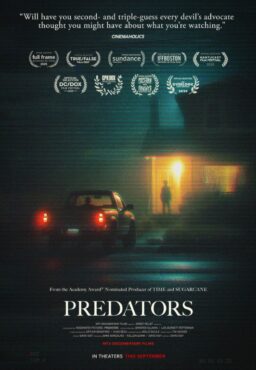Sofia Coppola attributes the ignition point of her career as a filmmaker to when she fell in love with Jeffrey Eugenides’ 1993 novel The Virgin Suicides and decided to adapt it lest someone else get there first and ruin it. The story is a far-gone memory fantasia of a group of neighborhood boys—long since become men—who were then and now fixated on the mystery that was the Lisbon sisters. If we search through her later work, it becomes Coppola would be drawn to it, as Eugenides’ book explores subject matter she’d return to again and again. The cloistered brutality of girlhood. Interiority expressed not through one’s own words, but through images and music and style. And cars. So many cars.
In the film version of “The Virgin Suicides,” we open on a teenage girl, a road behind her but not an open one. But the act of driving is insinuated from the very first moments of Coppola’s feature film debut, being not seen but heard. As we peer through the dreary suburban streets of Grosse Pointe, Michigan circa 1975, gradually rising above the warbly synth tones of Air’s score to “The Virgin Suicides” is the wail of the ambulance siren coming to the Lisbon home to deliver Cecilia, the youngest of the Lisbon’s five teenage daughters, from the restrictive Lisbon home, after she has slit her wrists in the tub. “That girl didn’t wanna die. She just wanted out of that house,” a neighbor woman remarks.
Coppola, whose strengths tend more atmospheric than dialogue-driven, is guided here by Eugenides’ text. Michigan serves as the automotive capital of the world and to the young men who populate this suburban universe, horsepower is a signifier of sexual maturity. The chorus of neighbor boys who serve as our narrators live just across the street from the Lisbons, they can only para-socially connect to the Lisbons, observing from afar or fantasizing about the girls as if they are divine aliens. Early on they are invited by Mr. and Mrs. Lisbon to “the only party the Lisbons ever had in their short lives,” likely because they pose no carnal risk in the parents’ eyes. It’s notable that in Michigan, an area defined by automobiles, these young men are never seen with a car of their own, at most being shown riding bikes. On the other end of the spectrum is Trip Fontaine, Grosse Pointe’s teen Casanova and “the only reliable boy who actually got to know Lux,” who’s introductory scene has him leaning against his crimson Pontiac Firebird followed by a montage of him wooing women and girls alike. When he comes over to watch TV with the Lisbons in an effort to court the most rebellious daughter, Lux, Mrs. Lisbon is strict with how the girls present themselves and sends him on his way early into the night, concerned about the feelings he might inspire in her youngest daughter. She is proven correct in her concerns when, immediately after he returns to his car, Lux jumps in and straddles him and passionately kisses him, set to the firey opening riff of Heart’s “Barracuda.”
To the Lisbon parents, a car is a dangerous thing, weakening their grasp over their daughters. They have special rules that the girls can’t go on dates and “especially not in a car.”
“We almost never let the girls go out in cars unless it’s necessary,” says Mrs Lisbon just before letting her then-surviving daughters go to homecoming with Trip and his football friends in one of their parent’s Cadillac. As the sisters ride to the dance, they loosen up in a way we haven’t seen before, not focused on the boys so much as the ability to giggle and gossip free from their mother’s watchful eye. We can see the car offer a certain freedom from their conservative home.
But Lux takes this a step further than the rest, represented perfectly by her being the only sister to sit in the front of the Cadillac and smoking weed with the boys while her older sisters are grouped together in the back and abstaining. For her, the car is essentially a rocket ship that lets her break free from an oppressive gravity and places her among the stars (which the homecoming dance is excessively decorated with) in a faraway world of adulthood glimmering with tinsel and peach schnapps and sexual agency. She goes beyond her sisters, and runs off with Trip to have her first sexual encounter in the football field, with the headlights of passing vehicles occasionally flashing over them.
When she falls asleep there in the wide-open field, missing curfew, and is abandoned by Trip, it’s all the more crushing watching her have to take a cab home, contemplating the freedom she will lose for the fleeting joy she gained. The parents completely crack down on all the girls after this, removing them from school and burning their rock records. Eventually, the girls begin communication with their admiring neighbor boys, through flashlight morse code and records played across the telephone, now the Lisbons only connection to the outside world of youth. Over time, the girls seemingly signal for an escape plan. The boys arrive late one night, eager to take the girls to freedom: “We got a car. A full tank. We’ll take you anywhere you wanna go.” They want to be chivalric heroes to these girls and to know them on some deeper level, but as the narration from the boys’ middle-aged future has reminded us throughout the film, they never will. They fantasize about driving away with the sisters but are shocked to find the Lisbon sisters have found freedom on their own terms, all ending their lives on the same night. Lux’s method of suicide holds the greatest symbolism, as she has started the family car in the garage and died of carbon monoxide poisoning. Having been denied control of her own life, she chose to die sitting behind the wheel in the end.

This theme of being a passenger in one’s own life comes up again and again in Coppola’s later work, with one of the most recurring shots in her filmography being her protagonists staring out the window with an overwhelming sense of ennui. Coppola’s films always exist in walled-off universes, and from here would focus on a more luxurious milieu, reflecting her own upbringing as the daughter of one of new Hollywood’s most prominent directors. “I imagine Sofia has spent a lot of time being chauffeured around,” says Hannah Strong, author of Sofia Coppola: Forever Young. Strong points out to me that this imagery first appears even before “Suicides,” with the opening shot of her first short film beginning the very same way: “the fact this specific imagery reoccurs so much throughout her filmography points to her own obsession with repeating images, something that she’s said is an unconscious habit. It reminds me of the way we might fixate on a favourite pair of shoes, or even a favourite book we return to over and over—there’s something comforting about it.”
In her two films following “Suicides,” “Lost in Translation” and “Marie Antoinette,” Coppola’s protagonists are rich public figures that feel at odds with the expectations put on them and occupying spaces they feel out of place in. “Translation”’s Bob Harris is a middle-aged movie star who has come to Japan to do an ad campaign for a whiskey company and struggles with culture shock while staying at the Park Hyatt Tokyo. Similarly, “Marie Antoinette” looks at the titular Austrian princess’ life once she marries into the French royal family of Versailles and looks at her having difficulty with the responsibilities put on her and feeling like a stranger amongst this foreign court. And while these films take place in different eras (2000s vs 1700s) and over very different periods of time (roughly a week vs. 20 years), it’s worth noting that both films mark their beginning, middle, and end with a ride in a car or carriage respectively.
“Translation” begins with Bob’s arrival to Tokyo. He wakes up in the back of a cab to an unfamiliar neon city with every building covered in bright Japanese letters he can’t make sense of, and for the first half of the film, he is completely lost and agitated by his inability to communicate effectively with anyone around him in Japan as well as with his wife back home. Eventually, he strikes an accord with Charlotte, an American woman likewise staying at the Park Hyatt Tokyo who, though half his age, is feeling similarly adrift in her life, her marriage, and in this setting. It’s only after the two venture out one night together that they finally are able to connect to another as well as appreciate the city’s beauty, represented by a serene drive back to their deluxe accommodations set to My Bloody Valentine’s distorted ballad “Sometimes.” The film’s ending mirrors its beginning, with Bob in a taxi headed back to the airport, but not before exchanging a heartfelt goodbye with Charlotte in the streets they came to know each other. Here I must add that while the film reaches for the ephemeral, its attempts to evoke isolation in a crowd and the splendor of the liminal completely fail by way of its protagonists’ (as well as its directors’) insufferable western exceptionalism. While they eventually recognize the beauty of their environment, they never recognize the Japanese people as actual people.
“Mary Antoinette”’s approach to the themes of culture clash in the gilded cage are far more successful, with Coppola using the French queen’s life to provide us with a lavish, anachronistically styled examination of girlhood in the limelight. The use of a trio of rides is used again here, but to mark the defining periods of her life. The first is at the outset of her betrothal to Dauphin Louis-Auguste, making her long journey from her native Austria to her Versailles. Here Coppola expresses emotional perspective with precision. On the first leg of the trip, Marie is still 14-year-old Maria Antonia, trying to distract herself by traveling with courtly friends in her compartment as she ventures through endless misty woods, being made to leave behind everything she’s known to secure her family’s alliance. The melancholic piano score expresses uncertainty. Once she reaches the hand-off point, she passes through a tent, leaving behind everything and everyone Austrian, becoming adorned in only that which is French, and riding on alone until she joins the French procession that will take her to her new home. The mist is gone, the sun shines, and music goes from classical to synth-driven indie rock. For four years, we do not see Marie leave Versailles. Her days are spent acknowledging the ritual of her new home, indulging in decadence, and failing to gain her husband’s affections, which she needs to sire an heir and cement her position.
The second ride comes after Marie and Louis sneak off with friends to a masquerade ball in disguise. Here, we see her encounter Count Fersen, with whom she shares her first moment of genuine desire, unorchestrated by governing bodies. As the horse-drawn carriage returns to her castle at daybreak to the sound of Bow Wow Wow’s “Fools Rush In,” she looks dreamily at the grounds. Upon arriving back to Versailles, they learn that King Louis XV is gravely ill and they, barely adults themselves, must ascend to the throne of France. Womanhood has begun for her all at once. As for the end, it mirrors the ending of Coppola’s preceding films but on a much larger scale: after years of Marie living in the utmost decadence as her subjects struggled and starved, the French Revolution has begun. Though the director doesn’t show us the queen’s violent (if just) end, the film’s closing moments make it very clear what is to come. Marie and her family are carried away from Versailles for their safety as she mournfully watches the sunset on her illustrious avenue for the last time.
Coppola often sees each of her films as being a reaction to the work directly preceding it, and while she returns to many of the same themes and environments, as her career has gone on, the meaning of the imagery has shifted in different ways. Nowhere is this more apparent than in 2010’s “Somewhere,” which takes the opposite approach to the candy-colored maximalism, feminine focus, and quick pace of “Marie Antoinette” while still exploring the emptiness of a certain upper-class excess, but through a very masculine lens.
“Somewhere” opens with a powerful static shot: a jet-black Ferrari drives round and around a racetrack in the middle of a flat, barren stretch of California desert. The ring of blacktop is so wide we can only see half of the looping road, watching the car barrel in and out of frame and hearing the thunder of the engine roar and hush with distance. Then, it slows to a stop just in front of us. A simply dressed, handsome, 30-something man steps out and surveys the vast expanse of nothingness that surrounds him. After a brief, minimalist opening credits sequence over black, we cut to Los Angeles’ most luxurious liminal space: the Chateau Marmont Hotel where that same man, divorced movie star Johnny Marco, currently resides long-term.
Johnny breaks his wrist carousing with his hangers-on one night, and though in a hand cast for the majority of the film, it doesn’t really change his fast-paced approach to life. He parties, gets drunk and/or high, watches twins pole dance in his room, has casual sex with beautiful starlets whose names he can’t remember, and that’s about it. As exciting as this all sounds, it is represented in a way that makes it clear how, despite him being popular, successful, and surrounded by the trappings of glamour, no one around him really likes him. Coppola’s direction of “Somewhere” is noticeably stripped down in comparison to that of all her preceding films, keeping visual saturation low and tending towards long still takes here to present the hollowness of Johnny’s life. Whereas Coppola’s previous protagonists felt burdened by expectations and responsibilities and sought definition for themselves separate from that ascribed by their environment, Johnny is stuck exactly because his life has no limiters, no restraints, and no rules. We often watch Johnny speed around LA in his sports car but he doesn’t seem to have anywhere to be.
A shift only occurs for Johnny when his 11-year-old daughter Cleo unexpectedly comes to stay with him when his ex-wife needs time to herself. He drives her to ice-skating practice. He takes her with him to an award show in Rome. He drives with her to Las Vegas and then takes her to camp in a helicopter. Coppola often expresses character perspective through design and atmosphere rather than through dialogue, and “Somewhere” is the pinnacle of this. Through the same long takes that showed the emptiness of Johnny’s existence, we now watch him share small moments with Cleo, as he has someone to care for in a way that he has been unable to care about himself.
Here we begin to see a subtle change in Coppola’s trademark ending, which she returns to again and again (and this will not be the last time)—a character vacates the one stifling space we’ve watched them occupy and drive toward a future uncertain to them, but for the first time, there is no melancholy to it. Johnny checks out of the Marmont, with no idea (or concern for that matter) where he will be staying next, but ready to move on. We watch him get in his Ferrari and speed off as we have so many times before but with a key change in perspective: while we’d previously watched him drive in profile, now we are right behind him as he drives through the city and the highway and the desert. For the first time there is a vista. Johnny is moving forward. And then at a certain point, on a stretch of road in the middle of nowhere, he pulls over. He gets out of the luxury vehicle, keys still in the ignition, and walks away from it into the horizon with a smile on his face, not once looking back.
There’s a fascinating dichotomy at play in Coppola’s utter vehicular fixation. While her characters may travel, she doesn’t make road films, with all her stories being very spacially enclosed. Characters may go from one setting to another but each place seems to exist as its own claustrophobic bubble. Perhaps it comes from her upbringing. In a recent New Yorker profile of the filmmaker, it’s mentioned how her father and fellow filmmaker, Francis Ford Coppola, took the whole family with him whenever he would go off to shoot a picture. This meant that despite their home base being in Napa, much of her childhood was spent on the move. “We were circus people, basically,” said Coppola in the profile. “I kind of mark my childhood by the movies.” This squares logically with the recurring struggle of her protagonists being discomfort and dissatisfaction when in stasis. For someone who was brought up in so many places, there must not be a more hellish idea than having to sit still.
There’s also the aspect of opulence and status that accompanies luxury vehicles, and it’s not hard to recognize the ways in which Coppola, an artist who values taste and beauty above all else, might find shining behemoths of stylized metal irresistible. In the period of her early twenties before she honed in on film as a vehicle for her many interests, Coppola existed mostly as a listless celebutante, living not dissimilarly to Johnny Marco, lounging in the pool at the Chateau Marmont and driving a black Cadillac Seville (after “Lost in Translation,” she would eventually trade this in for a Porsche, the same car Bob Harris considers buying as part of his midlife crisis).
This love of motor and machine comes most clearly into focus if we look back at her earliest created work in the audio-visual medium: “Hi Octane,” the briefly lived but aptly named Comedy Central show she produced as well as starred in along with Zoe Cassavetes (daughter of filmmaker John Cassavetes and actress Gena Rowlands). The show, which shot four episodes of which only three went to broadcast, was a chaotic mix of fast cars, goofy skits (involving cars), and interviews with any Gen-X celebrity the LA It girls had in their rolodex. “We didn’t care about making it look gorgeous or anything. It was really about the spirit of the show, the guests, and two young, hot, badass chicks in a car,” Cassavetes remarked in a 2020 retrospective Vogue piece. It was as close to anarchy as a child of nepotism can get.
An excerpt from a 1993 W Magazine profile of Coppola by Merle Ginsberg reads:
“[Coppola’s] real passions these days are cars, and ‘Hi Octane,’ which was inspired by her thing for automobiles. She stares lovingly at her red ’69 convertible GTO parked just a few feet away. My dad and my brother, Roman, are really into cars, and about a year ago, I got into cars in a serious way. It’s such a boy thing, all these boys have muscle cars, so I had to get my own.”
Interestingly, this pure admiration for the automobile has only begun to come thru in the last decade or so of Coppola’s career as she’s matured. It’s most apparent in her more clear-cut comedies, like 2013’s “The Bling Ring” or 2020’s “On the Rocks.” The former is a true crime story of a group of LA teens who rob a string of celebrity homes to feel close to the fame and excess these figures represent to them. The story is mainly told from the perspective of Marc, an impressionable gay boy who transfers to a new school in Agoura Hills and comes under the thrall of charismatic and unscrupulous Rebecca and her equally vapid clique of friends. For the first time, Coppola represents a city as a playground, as we watch these children play at stardom as they drive around in stolen Bentleys, Jaguars, and Escalades. Notably, Marc is never behind the wheel but always happy to be in the passenger seat or back while the girls drive, perfectly illustrating that he’s primarily going along with the crime spree so he will be accepted. When their complete lack of discretion on social media gets the group caught, the ironic penultimate scene shows Marc get in one last car: a prison bus.
In “On the Rocks,” Laura, a novelist living in Manhattan with her husband Dean and their two daughters, feels stuck in a rut with her creative career as well as her marriage. Dean is constantly on business trips for the tech start-up he founded, which leaves Laura alone to care for their two young daughters and with anxieties that her husband might be having an affair. When she shares her fears with her father Felix, a rich, larger-than life playboy who cheated on Laura’s mother, he only makes her fears worse, insisting that men are biologically incapable of fidelity. In a roundabout maneuver to have quality time with the daughter he neglected, Felix proposes that they investigate Dean together.
Here again, vehicles become toys and a representation of privilege and freedom, but the child here is Felix, who skirts responsibility and lives a life of leisure in semiretirement. Laura uses a Volvo to get her daughters from one place to another with barely any time for her own creative work, which is juxtaposed with Felix, who made his fortune of dealing the art of others, and spends most of his time being chauffeured in a Mercedes Benz by his driver Musto. He swoops in on Laura seemingly whenever he’s bored and lonely, spiriting her away to New York’s most upscale dining institutions to spout regressive views of gender dynamics and flirt with every waitress that he meets. Automotives even figure into how Felix discusses women (this is without a doubt Coppola’s most dialogue-heavy film), saying he hates plastic surgery as he prefers “the factory original,” with Laura retorting, “Yeah and every other make and model.”
In Coppola’s most playful driving scene to date, Felix convinces Laura they should follow Dean to a supposed business meeting, pulling up in what is likely the least discreet tail car possible, a bright red 1959 Alfa Romeo. The scene begins simple yet absurdly, with the father-daughter pair snacking on caviar and crackers while on lookout, before they notice Dean on the move and the old-fashioned man slams the pedal of his old-fashioned car, gunning it through NYC traffic before the vintage sports car predictably stalls. As the chase scene comes to a halt, the two are pulled over by the police, and Felix, in the film’s most blatant display of white male bravado, charms the cops out of giving him a ticket and gets them to push him back to a running start.
Finally, this love for vintage metal comes through again in Coppola’s most recent film, “Priscilla,” but here cars are used in a dramatic exploration of that brings to mind her earliest explorations of girlhood in the gilded cage. When the film begins in 1960, the woman who will become known to us as Priscilla Presley is 14-year-old Priscilla Beaulieu, a Texas girl living on an air force base with her parents in West Germany who feels isolated from anyone like her. When another serviceman offers to bring her to come meet the 24-year-old music sensation Elvis Presley, who is then stationed there as well, she is ecstatic even if her parents are reticent. When she rides in the backseat to go meet The King for the first time, we feel we are going with her on a journey. As she arrives at Graceland for the first time, car travel once again feels interplanetary, with the tail fins of the baby blue Cadillac she’s escorted through the gates in being wings that carry her into her to a world most girls her age could only dream of.
Priscilla gets her parent’s consent to move into Graceland in her senior year of high school. As her time in Memphis goes on, cracks begin to form in her fantasy. A pattern begins to form in her relationship with Presley that will last throughout it. When Elvis is home, he is controlling at best and emotionally violent at worst. Whenever he takes her out, it is never without his entourage, the Memphis Mafia, in tow, showing her off to them but never prioritizing her. He is committed to Priscilla in the sense that he provides for her material needs but not the emotional ones. He refuses to sleep with her for many years, seemingly fitting her into the role of a comforting Madonna figure in his late mother’s absence and threatens to send her home to her family any time she questions him. When Elvis is out touring or shooting movies, Priscilla is expected to stay at Graceland, idling away countless hours alone while the man she is committed to goes out sleeping with stars like Ann-Margret.
Here, “Priscilla” reveals itself to be a classic gothic romance set against a backdrop of nouveau riche celebrity. Though Elvis often spoils her, even gifting her a cherry red Coupe de Ville upon her graduation, the pattern of abuse and neglect continues with the colourful musical gates of the estate becoming the bars to her lavish prison. As with Coppola’s best work, we are transported into a perspective of someone who feels a passenger in a luxurious life that is less than they hoped for, trying to capture control without losing comfort and love. After ten years in a loving yet caustic relationship with Elvis, Priscilla decides to leave him and depart from Graceland for good and takes herself out through the gates on her own terms as Dolly Parton’s “I Will Always Love You” plays us to credits.
When I saw “Priscilla” in theaters this last November, it first struck me how often Coppola reuses this signature ending of hers, but “Priscilla”’s closing moments represent what is perhaps its greatest evolution for two reasons, the first being the symbolism of the music used. As my friend Harron Walker made me realize, “I Will Always Love You” was a song Elvis Presley famously tried and failed to own. The second reason being just what this recurring motif expresses: the end a film before the story is really over. What we get is a chapter in a life much too rich to tell all at once, punctuated with a ride into the next part of the saga. And for the first time in her career, Sofia Coppola shows us a grown woman at the wheel of her own destiny, driving towards an uncertain future.
To watch a Sofia Coppola film can often feel like she’s taking us on a scenic drive with her down a road she knows well. We try to make conversation but aside from remarks here and there about an opulent establishment she oft frequents, there isn’t much to be said. From the passenger seat we admire the view of the vista ahead of us, partially obscured by the assortment of luxury trinkets that litter her dashboard. We soak in the sound waves of her favorite mix CDs and decide we’ll likely explore more from those artists on our own. If we’ve driven with her before, we will likely not be surprised with where she takes us, but how we get to our destination, appreciating the curation with which she chooses the side streets and main ways. We are, as ever, along for the ride.
